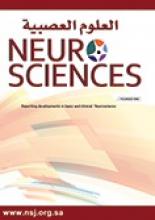Research ArticleOriginal Article
Open Access
Association of intron 4 VNTR polymorphism in the NOS3 gene with rapid cycling and treatment resistance in bipolar disorder: a case-control study
Hasan M. Aytac, Mustafa Pehlivan, Yasemin Oyaci and Sacide Pehlivan
Neurosciences Journal October 2022, 27 (4) 229-236; DOI: https://doi.org/10.17712/nsj.2022.4.20220040
Hasan M. Aytac
From the Department of Psychiatry (Aytac), Basaksehir Cam and Sakura City Hospital, from the Department of Hematology (Pehlivan), Gaziantep University, Gaziantep, from the Department of Medical Biology (Oyaci, Pehlivan), Istanbul Faculty of Medicine, Istanbul University, Turkey
MDMustafa Pehlivan
From the Department of Psychiatry (Aytac), Basaksehir Cam and Sakura City Hospital, from the Department of Hematology (Pehlivan), Gaziantep University, Gaziantep, from the Department of Medical Biology (Oyaci, Pehlivan), Istanbul Faculty of Medicine, Istanbul University, Turkey
MDYasemin Oyaci
From the Department of Psychiatry (Aytac), Basaksehir Cam and Sakura City Hospital, from the Department of Hematology (Pehlivan), Gaziantep University, Gaziantep, from the Department of Medical Biology (Oyaci, Pehlivan), Istanbul Faculty of Medicine, Istanbul University, Turkey
MScSacide Pehlivan
From the Department of Psychiatry (Aytac), Basaksehir Cam and Sakura City Hospital, from the Department of Hematology (Pehlivan), Gaziantep University, Gaziantep, from the Department of Medical Biology (Oyaci, Pehlivan), Istanbul Faculty of Medicine, Istanbul University, Turkey
MD
References
- 1.↵
- Machado-Vieira R,
- Soares JC.
- 2.↵
- 3.↵
- Muneer A.
- 4.
- Kamal NAM,
- Loo JL,
- Goon JA,
- Damanhuri HA,
- Sharip S,
- Saini SM, et al.
- 5.↵
- Aytac HM,
- Yazar MS,
- Erol A,
- Pehlivan S.
- 6.↵
- Nursal AF,
- Aytac HM,
- Yazar MS,
- Oyaci Y,
- Pehlivan M,
- Pehlivan S.
- 7.
- Aytac HM,
- Oyaci Y,
- Yazar MS,
- Erol A,
- Pehlivan S.
- 8.↵
- Aytac HM,
- Pehlivan S,
- Pehlivan M,
- Oyaci Y.
- 9.↵
- Oral E,
- Halici Z,
- Cinar I,
- Ozcan E,
- Kutlu Z.
- 10.↵
- 11.↵
- Nasyrova RF,
- Moskaleva PV,
- Vaiman EE,
- Shnayder NA,
- Blatt NL,
- Rizvanov AA.
- 12.↵
- Förstermann U,
- Sessa WC.
- 13.↵
- Tripathi MK,
- Kartawy M,
- Amal H.
- 14.↵
- Pehlivan S,
- Aytac HM,
- Ciftci HS,
- Oyaci Y,
- Pehlivan M,
- Nursal AF.
- 15.↵
- Antwi-Boasiako C,
- Dzudzor B,
- Kudzi W,
- Doku A,
- Dale CA,
- Sey F, et al
- 16.↵
- 17.↵
- Napoli C,
- Ignarro LJ.
- 18.↵
- 19.↵
- Cassidy F,
- Zhao C,
- Badger J,
- Claffey E,
- Dobrin S,
- Roche S, et al.
- 20.↵
- Association WM.
- 21.↵
- First MB,
- Spitzer RL,
- Gibbon M,
- Williams JB.
- 22.↵
- Çorapçıoğlu A,
- Aydemir Ö,
- Yıldız M,
- Esen A,
- Köroğlu E.
- 23.↵
- Young RC,
- Biggs JT,
- Ziegler VE,
- Meyer DA.
- 24.
- Karadağ F,
- Oral ET,
- Aran Yalçın F,
- Erten E.
- 25.
- Hamilton M.
- 26.
- Akdemir A,
- Örsel S,
- Dağ İ,
- Türkçapar H,
- İşcan N,
- Özbay H.
- 27.↵
- Guy W.
- 28.↵
- Sachs GS.
- 29.↵
- Association AP.
- 30.↵
- Erdem D,
- Buyuksimsek M,
- Gunaldi M,
- Isiksacan N,
- Pehlivan S.
- 31.↵
- Lee W-C,
- Wang L-Y.
- 32.
- Pehlivan S,
- İnalöz HS,
- Nursal AF,
- Gülel A,
- Pehlivan M.
- 33.↵
- Erol N,
- Kılıç C,
- Ulusoy M,
- Kececi M.
- 34.↵
- de Medeiros Alves V
- 35.↵
- 36.↵
- Selek S,
- Savas HA,
- Gergerlioglu HS,
- Bulbul F,
- Uz E,
- Yumru M.
- 37.↵
- Buoli M,
- Serati M,
- Altamura AC.
- 38.↵
- Kirov G,
- Murphy K,
- Arranz M,
- Jones I,
- McCandles F,
- Kunugi H, et al.
- 39.↵
- 40.↵
- Müller DJ,
- de Luca V,
- Sicard T,
- King N,
- Strauss J,
- Kennedy JL.
- 41.↵
- 42.↵
- 43.↵
- Munkholm K,
- Poulsen HE,
- Kessing LV,
- Vinberg M.
- 44.↵
- Kapur V,
- Nadella RK,
- Raghuraman BS,
- Saraf G,
- Mishra S,
- Srinivasmurthy N, et al.
- 45.↵
- Busner J,
- Targum SD.
- 46.↵
- Rybakowski J,
- Suwalska A,
- Skibinska M,
- Szczepankiewicz A,
- Leszczynska-Rodziewicz A,
- Permoda A, et al.
- 47.↵
- 48.↵
- 49.↵
- Mamdani F,
- Alda M,
- Grof P,
- Young LT,
- Rouleau G,
- Turecki G.
- 50.↵
In this issue
Association of intron 4 VNTR polymorphism in the NOS3 gene with rapid cycling and treatment resistance in bipolar disorder: a case-control study
Hasan M. Aytac, Mustafa Pehlivan, Yasemin Oyaci, Sacide Pehlivan
Neurosciences Journal Oct 2022, 27 (4) 229-236; DOI: 10.17712/nsj.2022.4.20220040
Jump to section
Related Articles
- No related articles found.





